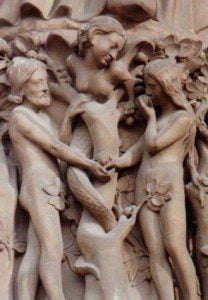We’ve been working through Denis O. Lamoureux’s book Evolutionary Creation: A Christian Approach to Evolution – a book that describes a way to move beyond the creation and evolutions debates. Chapter 7 provides Dr. Lamoureux’s vision of the means to move beyond conflict and concordance. His approach hinges on the Message Incident Principle separating the divinely inspired message from the incidental features of the text arising from the context of the day and age when it was produced. This is illustrated below.

The message contained within scripture is divinely inspired of God, but he accommodates his message to human limitations in understanding and knowledge. God proceeds stepwise in relationship to finite and limited human perspective. For example, a message of Genesis 1 is that God is creator, not how God created or the precise material form of what he created. Likewise a message of Genesis 2 is the God ordained institution of marriage; formation of Eve from Adam’s rib is incidental, not part of the message.
This leads to a key question often raised – what about Adam and Noah?
Does the message-incident approach to scripture help address the question of Adam and Noah as in some sense literal, historical individuals?
Dr. Lamoureux addresses the question of Adam and Noah in the last part of Chapter 7. While the answer may be easy or relatively unimportant if the text of Genesis is taken alone, the New Testament writers refer directly to these individuals. For many Christians this complicates the issue substantially.
Jesus, Adam, and Noah – In the accounts related in the Gospels Jesus refers to Genesis 2 and to the story of Noah in Genesis 6-9. The story of Noah is used as a warning when Jesus discusses the coming of the Son of Man:
But of that day and hour no one knows, not even the angels of heaven, nor the Son, but the Father alone. For the coming of the Son of Man will be just like the days of Noah. For as in those days before the flood they were eating and drinking, marrying and giving in marriage, until the day that Noah entered the ark, and they did not understand until the flood came and took them all away; so will the coming of the Son of Man be. Mt 24:36-39
This is an apocalyptic passage and the message-incident principle provides a useful guide to understanding. The message, as I read it, is that action of God is abrupt according to his own time. Human perspective leads to a false sense of security. Perhaps there is also an application – that we should remain alert, aware, and faithful before God. Certainly Matthew makes this point when he records Jesus using an illustration of the faithful and evil slaves in 24:45-51. But the story of Noah is incidental to the message, and the use of the story need not imply that Noah is historical or ahistorical. In Luke 17 Jesus is recorded as using the story of Lot and Sodom and Gomorrah to make the same point. Again the story is incidental to the message, and doesn’t speak to historicity. The historicity of Lot and Noah are issues to be judged on other grounds and the decision need not be the same for both passages of Genesis.
According to Dr. Lamoureux:
References to Noah and the flood by Jesus and Peter do not prove the historicity of this man or destructive event. Nor does their mention in the New Testament make Gen 6-9 historical. The existence of Noah and the reality of a worldwide deluge were facts of history for the Jews and early Christians. But these notions were part of an ancient understanding of history. The appearance of Noah and the flood in the New Testament does not confirm their reality or confer historicity to them any more than references to a 3-tier universe by Jesus and Peter establish this as the structure of the cosmos. (p. 278)
Jesus also refers to Gen 1 and 2 in a fashion that does not require historicity of Adam and Eve for the truth of the intended message. In Matthew 19 Jesus replies to a query from some Pharisees regarding divorce (the same exchange is related in Mark 10:6-9 as well):
And He answered and said, “Have you not read that He who created them from the beginning made them male and female, and said, ‘for this reason a man shall leave his father and mother and be joined to his wife, and the two shall become one flesh’? So they are no longer two, but one flesh. What therefore God has joined together, let no man separate.” Mt 19:4-6.
This passage reflects on the God ordained institution of marriage, a message that is also a key point in Gen 2. In other words this message of Gen 2 is the message Jesus expands upon in his exchange with the Pharisees. This exchange does not speak to the literary form of Gen 2, nor is it impacted by the historicity of Adam and Eve as unique individuals.
The message-incident principle helps on many levels here. It is clear that the message is not connected with the “historicity” of Adam or Noah, and it doesn’t even really matter if Jesus or the evangelists thought of Noah and Adam as unique historical individuals. There are no real theological problems.
Paul and Adam – Paul’s references to Adam, particularly his references in Romans 5 and 1 Corinthians 15 are somewhat more difficult to deal with. Here Dr. Lamoureax’s argument does not seem to do justice to the depth of the theological questions.
Genesis 1-3 is not a literal historical account of the origin of humanity. In making this case Dr. Lamoureux lists a number of features of the text of Genesis 1-11 that point away from the literal historicity of Adam and Eve, including the literary genre, the implications of ancient science, the contradictory order of creation events, the purpose of the text for tribal formation including the form of the name “adam” as a Hebrew word meaning “man” in the generic sense, and the nature of ancient genealogies.
Coming from the other direction, looking at the scientific evidence, Dr. Lamoureux summarizes geology, anthropology, archaeology, and ANE history in making the case against a unique pair as progenitor of the entire human race. The evidence is quite clear. He does not mention the genetic evidence embedded in the human genome – but this is even more conclusive in my opinion than the evidence he does cite.
Dr. Lamoureux also points out that Adam is not a part of any of the early church creeds. The profound significance of Adam in the doctrine of Sin is a relatively late development in the church, without a great deal of evidence before Augustine … unless, of course, one reads Paul as teaching this.
Dr. Lamoureux concludes:
The biblical and scientific evidence does not support the historicity of Adam. Undoubtedly, all the inspired authors of Scripture believed that he had literally once existed. But this was the science and history-of-the-day. Nevertheless, Adam plays a vital role in the Bible. He is an incidental ancient vessel used by the Holy Spirit to reveal the Messages of Faith that God created humans in His Image, they wilfully sin against Him, and He judges men and women for their sinfulness. To be sure, the conclusion that Adam never existed has significant implications for the events in Gen 3 and the origins of sin, suffering, and death. These are dealt with in the next chapter. (p. 276-277)
Adam, Sin, the Fall, and Questions Remaining – I agree with every point Dr. Lamoureux makes here about Genesis and about the scientific evidence. Not only this, but the idea that without the Fall there would have been no biological death or suffering of any sort is not even a consistent view within the church over the millenia. While a young earth and a unique, historical, individual couple, Adam and Eve, was the general consensus within the church, Christian thinking about the text of Genesis has been deep and varied on related issues, including death. To cite one example, John Calvin’s commentary on Genesis makes this clear – both from his own view of Gen 2-3 and from the various views he mentions and disagrees with in his commentary. A careful reading of Gen 3, independent of the historicity of Adam, has significant implications for the origins of sin, suffering, and death. Much of what is taught within the conservative Protestant church today is inconsistent with the text of Genesis and with the way the text has been read and wrestled with through the years.
While the message-incident principle is a useful starting point in considering Paul’s use of Adam, there are still profound questions. The real issues we need to deal with in discussing Paul’s use of Adam are more subtle – and more theologically significant – than the issues raised by Jesus’s references to Noah and to marriage. As I see it there are two major issues to be considered. The first is the universality of sin and of human guilt and accountability. The second is the nature of the atonement through the life, death, and resurrection of Jesus as God’s Messiah. These are tied up, not so much in the historicity of Adam, as in the historicity, in some sense, of a fall. They leads us to think more deeply about the message of scripture and about what is, or could be, incidental to the the message of scripture.
The next post in this series will look at Ch. 8 A Christian Approach to Human Evolution and Dr. Lamoureux’s approach to questions of sin in more detail. For today I would like to stop here and pose the question:
What do you see as the most significant issue raised by Paul’s discussion of Adam in Romans 5 and 1 Corinthians 15? Does his message depend on the historicity of Adam and/or of the Fall?
Or asked a little differently:
What is the message of Genesis 3, Romans 5, and 1 Cor. 15 and what features are incidental? How might the message be separated from the incidental features of the way this message is presented?
It you wish to contact me directly you may do so at rjs4mail[at]att.net
If interested you can subscribe to a full text feed of my posts at Musings on Science and Theology.
For those who find the full book (400+ pages) somewhat daunting Dr. Lamoureux has condensed the book into a more accessible version, I Love Jesus & I Accept Evolution. He also provides audio and slide summaries of each chapter of Evolutionary Creation online.










